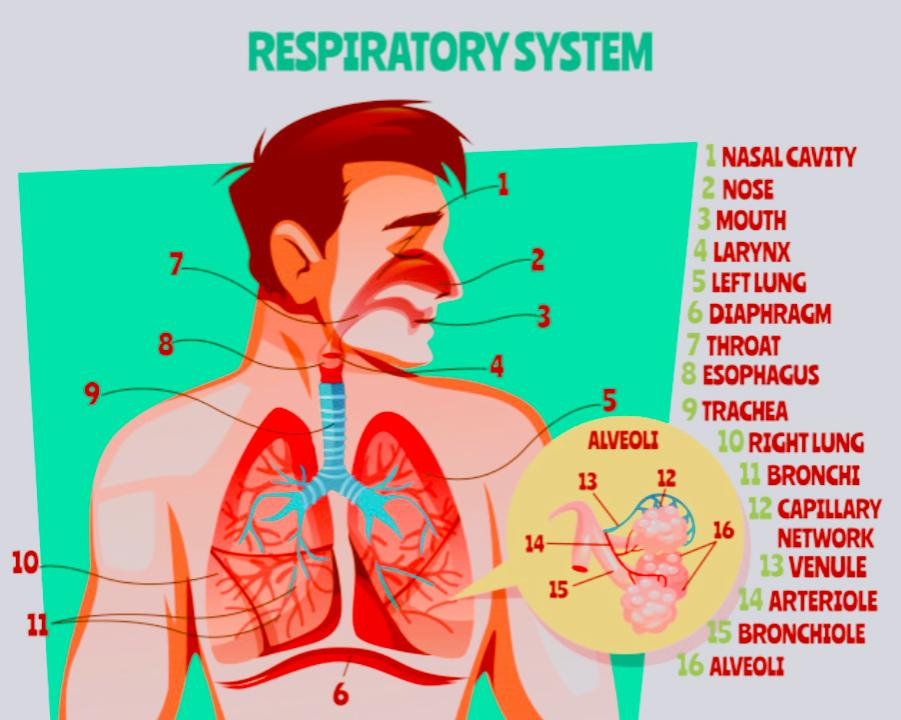
Which of the following statement(s) is( are ) true for respiration.
a. During respiration, ribs move inwards, and diaphragm raise.
b. In the alveoli, exchange of gases take place, i.e. oxygen from alveolar air diffuses into blood and carbon dioxide from blood into alveolar air.
c. Haemoglobin has a greater affinity for oxygen than carbon dioxide.
d. Alveoli increases the surface area for the exchange of gases.
A. ( a ) and ( d )
B. ( b ) and ( c )
C. ( a ) and ( c )
D. ( b ) , ( c ) and ( d )
Answer
573k+ views
Hint: The process of exchange of oxygen from the atmosphere with carbon dioxide produced by the cells is called respiration or breathing.
Step by step answer:

Mechanism of breathing or respiration :
Inspiration: It is the process by which atmospheric air enters into our nasal chamber. Inspiration is initiated by the contraction of the diaphragm by which increases the volume of the thoracic chamber. The contraction of external intercostal muscles lifts up the ribs in the sternum causing an increase in the volume of the thoracic chamber. This overall increase in the thoracic volume causes an increase in the pulmonary volume. Due to an increase in pulmonary volume, pulmonary pressure decreases less than the atmospheric pressure which forces the air from outside to move in the lungs.
Expiration: It is the process by which carbon dioxide is removed from the nasal chamber. Relaxation of the diaphragm and the intercostal muscles return the diaphragm to their normal position in reduced threshing volumes and thereby the pulmonary volume. This leads to an increase in pulmonary pressure than the atmospheric pressure which causes the air to more out.
Haemoglobin has a greater affinity for carbon dioxide than oxygen.
Alveoli increase the lung surface area for the exchange of gases.
Hence option D is correct.
Additional information :
-Haemoglobin has 200% more affinity for carbon monoxide.
-The pharynx is a common passage for food and air.
-The larynx is the soundbox.
-During swallowing epiglottis prevents the food from entering the larynx.
-Amphibians like frogs can respire through the most skin also and lungs
Note: Respiration involves two major processes i.e., inspiration or inflow of air and expiration or outflow of the air. In inspiration fresh air enters the lungs (contraction of external intercostal muscles) while in expiration foul air is expelled out into the atmosphere (relaxation of the diaphragm and the intercostal muscles).
Step by step answer:

Mechanism of breathing or respiration :
Inspiration: It is the process by which atmospheric air enters into our nasal chamber. Inspiration is initiated by the contraction of the diaphragm by which increases the volume of the thoracic chamber. The contraction of external intercostal muscles lifts up the ribs in the sternum causing an increase in the volume of the thoracic chamber. This overall increase in the thoracic volume causes an increase in the pulmonary volume. Due to an increase in pulmonary volume, pulmonary pressure decreases less than the atmospheric pressure which forces the air from outside to move in the lungs.
Expiration: It is the process by which carbon dioxide is removed from the nasal chamber. Relaxation of the diaphragm and the intercostal muscles return the diaphragm to their normal position in reduced threshing volumes and thereby the pulmonary volume. This leads to an increase in pulmonary pressure than the atmospheric pressure which causes the air to more out.
Haemoglobin has a greater affinity for carbon dioxide than oxygen.
Alveoli increase the lung surface area for the exchange of gases.
Hence option D is correct.
Additional information :
-Haemoglobin has 200% more affinity for carbon monoxide.
-The pharynx is a common passage for food and air.
-The larynx is the soundbox.
-During swallowing epiglottis prevents the food from entering the larynx.
-Amphibians like frogs can respire through the most skin also and lungs
Note: Respiration involves two major processes i.e., inspiration or inflow of air and expiration or outflow of the air. In inspiration fresh air enters the lungs (contraction of external intercostal muscles) while in expiration foul air is expelled out into the atmosphere (relaxation of the diaphragm and the intercostal muscles).
Recently Updated Pages
Why are manures considered better than fertilizers class 11 biology CBSE

Find the coordinates of the midpoint of the line segment class 11 maths CBSE

Distinguish between static friction limiting friction class 11 physics CBSE

The Chairman of the constituent Assembly was A Jawaharlal class 11 social science CBSE

The first National Commission on Labour NCL submitted class 11 social science CBSE

Number of all subshell of n + l 7 is A 4 B 5 C 6 D class 11 chemistry CBSE

Trending doubts
10 examples of friction in our daily life

One Metric ton is equal to kg A 10000 B 1000 C 100 class 11 physics CBSE

Difference Between Prokaryotic Cells and Eukaryotic Cells

1 Quintal is equal to a 110 kg b 10 kg c 100kg d 1000 class 11 physics CBSE

State the laws of reflection of light

Explain zero factorial class 11 maths CBSE




